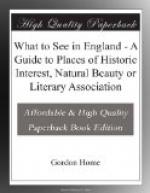Grasmere is the name of a village and lake in Westmorland, about 3 miles north-west of Ambleside. The lovely village, beautifully situated at the head of the lake, has an old church containing the grave of Wordsworth. Wordsworth’s cottage (a charge of 6d. is made for admission) is only half a mile from the church. It is restored, as far as possible, to its condition in Wordsworth’s day, and contains a number of relics of the poet’s family. The lake, a mile in length, and surrounded by mountains, forms one of the most beautiful scenes in England. Wordsworth afterwards removed to Rydal Mount (two or three miles off), which place remains especially associated with his memory. It is a somewhat remarkable fact that this quiet and thoughtful interpreter of nature was in the early years of his life, while going on a pedestrian tour through France, thrust into the early fervours of its great Revolution. Wordsworth’s sympathy with the aims of the Gironde party might have cost him his life, for many of his friends in Paris suffered death, but happily circumstances caused him to return to England. It was his noble sister Dorothy, his constant and devoted companion, who met him on his return from Paris, broken-hearted, and induced him to return to nature.
Wordsworth’s poetry was not appreciated for a considerable time, but he calmly wrote on, undismayed by the ridicule poured forth on the “Lake School of Poets,” which included Coleridge and Southey, and gradually his calm and dignified descriptions of nature asserted their rightful influence. After publishing his greatest poem, The Excursion, the tide of generous appreciation set in. In 1843, Wordsworth was made Poet Laureate. His pure and fervent poetry was a protest against the diseased sentimentality of the age.
[Illustration: Photochrom Co., Ltd.
RYDAL WATER.]
THE LAKE DISTRICT
=How to get there.=—Train to Ambleside
from Euston. London and
N.W. Railway.
=Nearest Station.=—Ambleside (for visiting
Coniston, Grasmere, Hawkshead,
Patterdale, and Windermere).
=Distance from London.=—260 miles. =Average
Time.=—Varies between 6 to 8 hours.
1st
2nd 3rd
=Fares.=—Single 39s. 0d. 25s. 2d. 23s.
0d.
Return
76s. 4d. 49s. 4d. 45s. 0d.
=Accommodation Obtainable.=—At Ambleside—“Queen’s
Hotel,”
“White Lion Hotel,” “Royal
Oak Inn,” “Robinson’s Temperance
Hotel.”
=Alternative Route.=—Train from St. Pancras.
Midland Railway.
Ambleside, situated in the very centre of the Lake District, is by many regarded as the most tempting spot in the whole region.
It is a long and straggling town of about 2000 inhabitants. The old church stands up the hill, in the more picturesque part of the town. The old ceremony of “rush-bearing,” dating from the time of Gregory IV., is still, in a modified form, an annual function in Ambleside, which, with one or two Westmorland villages, can claim the custom as unique.




